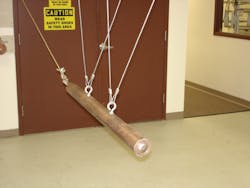How many times does the average person test that their door is properly locked before leaving the house? It is hard to say. But chances are that lock has already gone through its own rounds of testing before they even had the chance to worry about whether or not they locked it.
The Builder’s Hardware Manufacturers Association (BHMA) is the nationally leading trade association for the builder’s hardware manufacturing industry. BHMA is composed of more than 80 percent of all U.S. manufacturers of builder’s hardware in categories such as cabinet hardware and hinges, sliding and folding door hardware, and power doors and components.
BHMA is the only U.S. organization which is accredited by the American National Standards Institute (ANSI) to create standards for builder’s hardware. ANSI/BHMA standards are the written criteria which define the appropriate operation, test values, safety criteria, etc. of builder’s hardware products. In addition to ensuring hardware quality and performance through its development of standards, BHMA also sponsors third-party certification of hardware products.
This process satisfies two of the guiding values of the BHMA Mission: “To protect and secure the welfare, safety and common good of the general public” and “To engage in technical and other cooperative efforts to improve industry products.”
37 Lock Standards
A particular focus of the Standards and Certifications process is on the locks product category.
BHMA has 37 different lock standards, numbering 156.0 to 156.36, which all apply to the various and differentiating use of locks.
The most commonly used lock BHMA Standards are the following:
- 156.6 cylinders
- 156.30 high security cylinders
- 156.28 master key
- 156.2 board locks
- 156.13 mortise
- 156.36 auxiliary locks
- 156.3 exit devices
- 156.12 interconnected apartment.
Locks are such an important focus of the BHMA as they are such a vital part of people’s everyday lives. High-technology offers many new ways to protect and guard a home or business, but any of the more basic kinds of locks still provide essential security to people across the country, and serve as a last line of protection when other forms of security break down. Even in this high tech world, locks are still an essential source of security, and this is why BHMA goes through such lengths to ensure properly functioning locks are what reach the market.
Locks receive a standard accreditation after undergoing vigorous third party testing. The benefits of this are twofold. Firstly, this is done to ensure a high level of ever increasing performance in the industry, as standards are slowly modified upwards over time. Secondly, it ensures that consumers can be assured of what they buy in the marketplace, allowing them to make informed comparisons between different products, and allowing them to be assured of the safety of the product they purchase.
Most lock manufacturers have their own testing facilities where their products are examined before going to market or being submitted for certification. However, BHMA relies on independent 3rd party testing facilities, to ensure independent and fair verification. The main 3rd party testing facilities are Underwriters Laboratories, Architectural Testing Inc. and Intertek Testing Services. All of the various testing facilities use similar testing procedures for each lock category.
The main tests which are most commonly used are operational tests, strength tests, cycle tests, security tests and finish tests, which are almost always required.
The tests seek to test the performance of various aspects of locks.
Operational tests gauge the amount of torque or force per inch that is necessary to latch or unlatch the lock, both with and without a key. This determines how much strength an individual will have to use to successfully operate a lock.
Strength tests are used to determine the amount of force that knobs and levers can withstand while still remaining functional. So this would determine if a lock will break easily if too much force is applied to using it, which it should not.
Cycle tests require that locks and latches continue to operate properly after being opened and closed repeatedly. Oftentimes a mechanical machine will cycle the use of the product in the way it would normally be used over and over, such as 1,000,000 cycles for Standard 156.13, and then it will be judged whether or not the lock still works as it should.
Security tests subject the locks to physical beat downs and then measure how well they still perform as a locking device. Impacts and rams and often deployed to smash and batter the locks, which are then examined as to whether they will still keep an intruder out of a door or other entrance.
Finish tests test how well the lock parts will stand up to corrosion. They are generally subjected to a salt spray, humidity chamber, integrity coating, abrasion tests, perspiration tests and UV tests. Different tests are used for different kinds of locks, and are prescribed in their individual BHMA Standards.
Combined, these tests give the Standard evaluators a comprehensive look at the effectiveness of any particular lock, and whether it meets the standards set for it.
These kinds of performance tests are essential to the industry, as then ensure a high level of performance and support consumer confidence.
Moving forward, BHMA will be expanding various Standards, such as 156.25, for electronic locks, as this is a new and exciting niche of the lock industry that more and more consumers are beginning to rely on.
Whatever moves the industry might take in the future BHMA Standards and Certifications are an essential component of ensuring the safety of those who continue to rely on traditional locks, as many do and will for a long time.
For more information on the BHMA, visit www.buildershardware.com.






